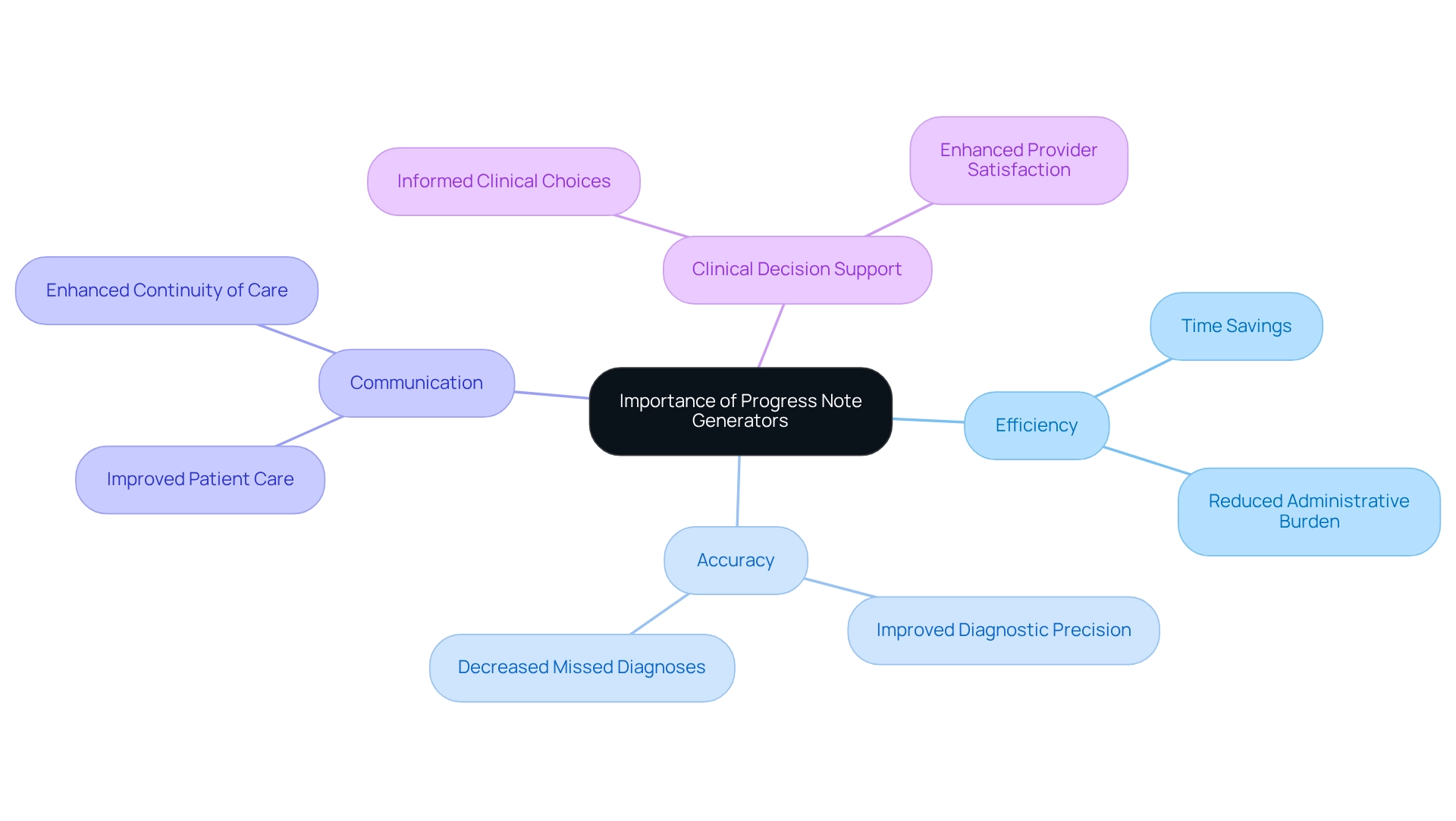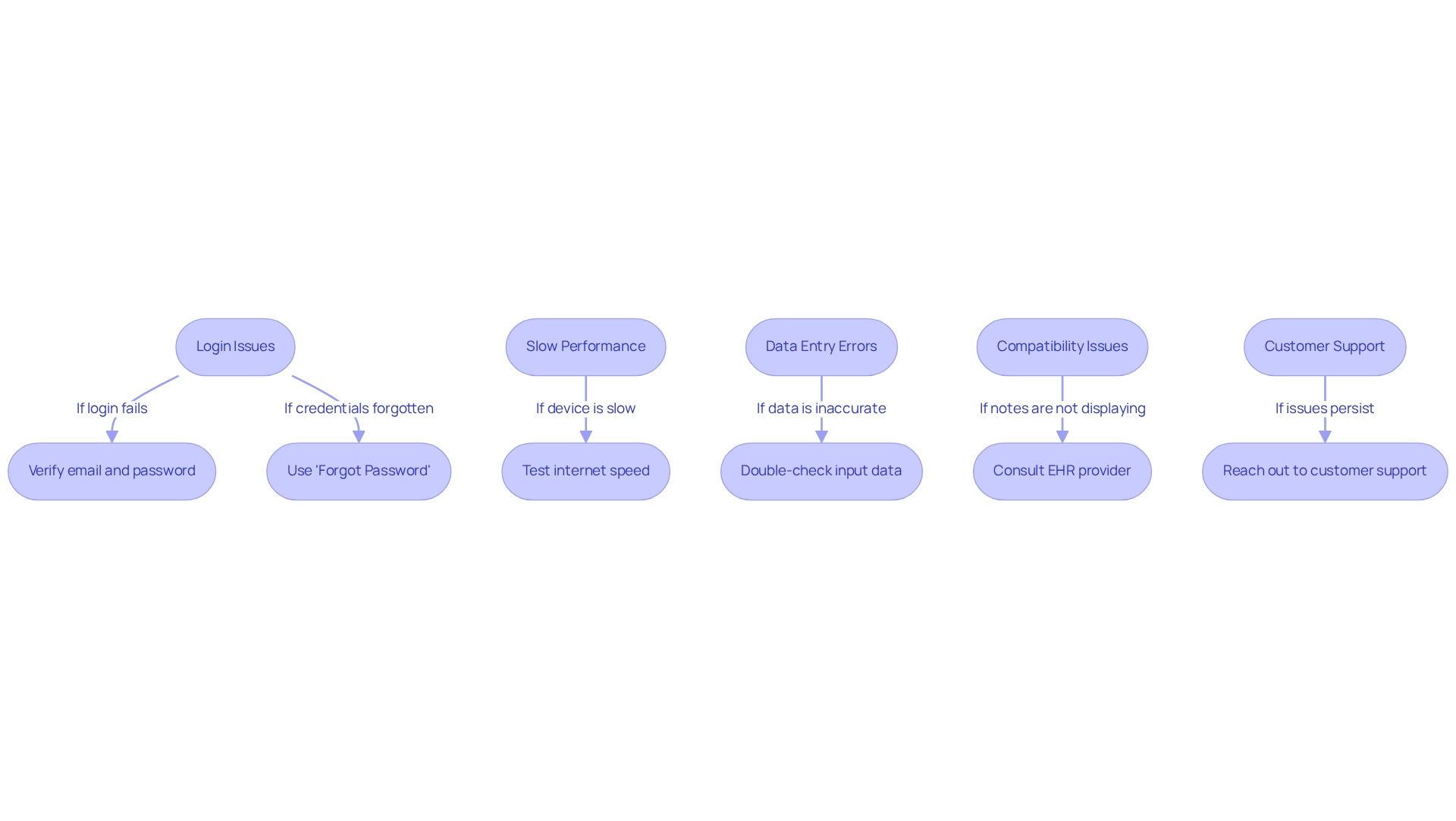Overview
In the demanding world of healthcare, providers often face overwhelming administrative burdens that can detract from the quality of patient care. Have you ever felt the weight of paperwork overshadowing your ability to connect with your patients? The good news is that there are effective solutions available to help you navigate these challenges.
This article outlines four essential steps for effectively using a free progress note generator:
- Access the tool.
- Input patient information.
- Generate notes.
- Troubleshoot common issues that may arise.
By following these steps, you can streamline your documentation processes and significantly reduce the time spent on administrative tasks.
Imagine the relief of having more time to focus on your patients, enhancing their care through improved efficiency and accuracy in record-keeping. The benefits are clear: less time on paperwork means more time for what truly matters—your patients. We encourage you to explore this tool further and see how it can support your practice. Together, we can transform the way you manage documentation, allowing you to provide the compassionate care your patients deserve.
Introduction
In the evolving landscape of healthcare, it’s crucial to recognize the emotional toll that inefficient documentation can take on providers. The emergence of progress note generators serves as a beacon of hope, transforming the way patient encounters are recorded and managed. By automating the documentation process, these digital solutions not only enhance accuracy and compliance but also significantly alleviate the burden of administrative tasks. This allows clinicians to devote more time to what truly matters—caring for their patients.
As healthcare providers strive to improve patient care, the integration of these innovative tools offers a pathway to better communication and streamlined workflows. Imagine the relief of knowing that documentation is handled efficiently, freeing up precious time to focus on patient interactions. The benefits are profound: improved patient outcomes and a more fulfilling work experience for healthcare professionals.
This article delves into the significance of progress note generators, their setup, and practical tips for maximizing their effectiveness. Together, let’s explore how these tools can empower you to enhance your practice and, ultimately, the care you provide.
Understand Progress Note Generators and Their Importance
The free progress note generator is a vital digital resource that significantly enhances the development of organized records for client interactions through effective progress documentation tools. Have you ever felt overwhelmed by the volume of notes to take? By automating the note-taking process, these tools ensure that essential information is recorded precisely and effectively. The importance of development records extends beyond simple documentation; they play a crucial role in monitoring individual advancement, improving communication among healthcare teams, and ensuring adherence to legal and regulatory requirements.
Imagine conserving time and minimizing errors while improving the quality of care offered to individuals. Employing a free progress note generator enables providers to achieve just that. For instance, a well-organized SOAP record (Subjective, Objective, Assessment, Plan) provides a thorough summary of an individual's condition and treatment strategy, aiding informed clinical choices. Research shows that instruments designed for diagnostic decision-making have slightly enhanced diagnostic precision, significantly decreasing overlooked diagnoses.
Expert views highlight the significance of progress notes in healthcare. Effective clinical decision support (CDS) implementation relies not only on clinician involvement but also on translating CDS application into enhanced clinical outcomes and satisfaction for both providers and those receiving care. Have you considered how organized documentation can impact healthcare outcomes? It promotes improved continuity of care and enhances overall safety. The transition to digital documentation tools, such as a free progress note generator, has transformed the quality of care. These tools not only enhance efficiency but also lead to improved outcomes by ensuring that healthcare providers have access to precise and timely information.
By automating administrative tasks like appointment scheduling and medical record handling, documentation creators result in substantial time savings for clinicians. This can lead to possible revenue increases through enhanced billing and improved job satisfaction by reducing administrative loads. In conclusion, documentation tools are essential in contemporary healthcare, fostering advancements in record-keeping methods and ultimately improving patient care. Let’s embrace these tools to support our journey in providing compassionate and effective care.

Access and Set Up Your Free Progress Note Generator
To access a free progress note generator, begin by exploring the options available online. Websites like Easy-Peasy.AI or SOAPNoteAI provide free trials or fully functional free versions. For example, AutoNotes allows users to create up to 10 documents a month at no cost. Once you select a generator, follow these simple steps to set it up:
- Visit the site: Navigate to the website of your chosen document creator.
- Create an Account: Sign up for a free account by providing your email address and creating a password. Some platforms may require email verification.
- Choose Your Note Type: After logging in, select the type of note you wish to generate (e.g., SOAP, DAP).
- Familiarize Yourself with the Interface: Take a moment to explore the dashboard and available features, ensuring you understand how to navigate the tool effectively.
Using these tools can significantly reduce documentation time, with some users reporting a decrease from 20-45 minutes to just 5-10 minutes per session. As Matt Griffin, a Drug and Alcohol Counselor, shares, "AutoNotes has been a game-changer for sure! I used to spend 20-45 minutes documenting and charting; this has reduced it to 5-10 minutes! I actually have so much time to focus on client care now!" This newfound efficiency allows healthcare providers to dedicate more time to client care, ultimately enhancing overall service delivery. The adoption of AI tools, including a free progress note generator, is increasingly recognized as an essential strategy for healthcare practitioners. These tools address the administrative burdens that often lead to physician burnout, facilitating a more patient-centered approach to care.
Are you ready to reclaim your time and enhance your focus on what truly matters? Explore these options today and discover how they can transform your practice!
Input Patient Information and Generate Notes
Once your progress note generator is set up, you can begin inputting patient information by following these steps:
- Select the Individual: Choose the individual from your records or create a new profile if necessary.
- Enter Session Details: Input relevant details such as the date, session type, and duration of the visit.
- Document Patient Information: Fill in the subjective and objective data, including the patient's concerns, symptoms, and any pertinent medical history. Utilizing clinical terminology is crucial for enhancing clarity and ensuring accurate communication among healthcare professionals.
- Generate the Note: After entering all necessary information, click the 'Generate' button. The free progress note generator will compile the data into a structured progress record format, which will be ready for your review and editing.
- Review and Edit: Before finalizing, carefully review the generated note for accuracy and completeness. Make any necessary adjustments to ensure it accurately reflects the session.
It's understandable that managing documentation can feel overwhelming. Statistics indicate that automated documentation tools can significantly enhance the accuracy of client information. In fact, studies show that over 80% of providers using such tools report improved efficiency in note-taking. Notably, over 80,000 providers are currently utilizing Sunoh.ai to automate their documentation workflows, demonstrating the widespread adoption of these technologies.
By streamlining the documentation process using a free progress note generator, healthcare providers can reclaim valuable time, allowing them to focus more on patient care rather than administrative tasks. Imagine what you could achieve with that extra time! As Dr. Judith Birungi, MD, noted, "We are interested in leveraging AI dictation through Sunoh.ai to provide physicians relief from intricate documentation and alleviate administrative workload." This is a step towards a more compassionate approach to healthcare, where your focus can remain on what truly matters—your patients.
Troubleshoot Common Issues with Progress Note Generators
For healthcare providers, using a free progress note generator can sometimes feel overwhelming. It's important to recognize these challenges and address them with compassion. Here are some supportive troubleshooting tips to enhance your experience:
- Login Issues: If logging in proves difficult, take a moment to verify your email and password. It's worth noting that around 30% of healthcare providers face login issues with digital tools. If you've forgotten your credentials, don't hesitate to use the 'Forgot Password' feature to initiate a reset.
- Slow Performance: A sluggish device can often stem from an unstable internet connection. Ensuring a reliable connection is essential for optimal functionality. Consider testing your internet speed to see if it meets the requirements for smooth operation.
- Data Entry Errors: If you notice inaccuracies in your records, carefully review the input data. Confirm that all mandatory fields are filled out correctly. A case study revealed that double-checking input data can reduce errors by 25%—a significant improvement.
- Compatibility Issues: If notes aren’t displaying accurately in your Electronic Health Record (EHR) system, take a moment to examine the compatibility settings or export options available within the tool. Consulting with your EHR provider can also shed light on resolving these issues.
- Customer Support: For persistent challenges, reaching out to the generator's customer support team can be invaluable. Many platforms offer chat or email support to assist with technical difficulties. Experts in digital healthcare tools stress the importance of utilizing a free progress note generator and other resources to resolve issues efficiently. By following these tips, healthcare providers can navigate common technical issues more effectively, ensuring a smoother documentation process. Remember, you are not alone in this journey—support is always available.

Conclusion
The integration of progress note generators into healthcare practices represents a meaningful shift in how patient encounters are documented. These tools not only simplify the documentation process but also improve accuracy and compliance, ultimately enhancing the quality of care provided to patients. By automating administrative tasks, clinicians can devote more time to patient interactions, which leads to better outcomes and a more fulfilling work experience.
Setting up and using these generators is straightforward, offering healthcare providers a valuable opportunity to reclaim time that was once consumed by tedious note-taking. Many providers have reported a significant reduction in documentation time, enabling a more patient-centered approach to care. Additionally, the ability to generate structured and accurate progress notes ensures that essential patient information is consistently captured and effectively communicated among healthcare teams.
While introducing new technologies can pose challenges, the advantages far exceed the obstacles. By tackling common issues and leveraging available support, healthcare professionals can enhance their documentation practices, lessen administrative burdens, and ultimately improve the overall effectiveness of their care delivery. Embracing progress note generators is not merely a step toward efficiency; it is a commitment to delivering the highest quality of care for patients in an increasingly complex healthcare landscape.




